
Most of us can’t start our day without our morning cup o’ Joe. In fact, the majority of US adults consume more than one cup per day and spend an average of $1100 each year on coffee! Whether you prefer Americano, decaf, espresso, macchiato, or iced, with cream, sugar or just plain black – coffee is one of the most popular beverages consumed world-wide. But, it’s not just a guilty pleasure – containing over 800 different phytonutrients, there is sufficient “grounds” to suggest coffee can provide a range of health “percs!”
The majority of US adults consume more than one cup of coffee per day and spend an average of $1100 each year on coffee!
Coffee (in a form similar to today’s modern beverage) dates back to at least the 15th century, where it was used by Sufis in Yemen to help boost concentration and to stay awake during religious rituals. One legend has it that the coffee plant was originally discovered by a goat herder in North Africa around 850 CE. Supposedly he noticed how excited his goats became after eating the beans from the plant and the rest is history. By the 16th century, coffee had reached the rest of the Middle East and North Africa, later spreading to Europe via Italy and from there to the Americas. (Interestingly, the first coffee seeds had to be smuggled out of Yemen as all exported coffee was sterilized for export.) Today, coffee is a major trade commodity, especially important as a source of revenue for developing countries.
Coffee is a major trade commodity, especially important as a source of revenue for developing countries.
But where exactly does coffee come from and how does it get into our cup? Coffee is actually prepared from roasted coffee beans, which are the seeds of berries from several species of Coffea shrubs. Coffee is cultivated by plantations that exist in over 70 countries all over the world between the tropics of Cancer and Capricorn (aptly named the coffee belt!). The most common species of coffee are Coffea arabica and Coffea canephora (known as robusta). Reports say that the Arabica coffee is generally a “superior cup” quality- and aroma-wise, but Robusta appears to have a stronger flavor with more antioxidants and caffeine. While beans from different countries or regions are known for different taste characteristics including flavor, aroma, body, and acidity. But, how do the beans become a delicious beverage? The process starts when the coffee fruit matures to bright red berries. Once the fruit is picked, the outer pulp, called the pericarp, is removed, resulting in what is known as green coffee beans. Green coffee beans are known for their rich antioxidant content, but there are also additional antioxidants created in the roasting process. These beans can be roasted on-site at the plantation or, perhaps, at your local coffee shop. The roasting process influences the taste of the beverage by changing the coffee bean both physically and chemically. At this point, depending on the color of the roasted beans, the coffee will be labeled light, medium, medium dark, dark, or very dark. Fresh-roasted beans (compared with beans that may have been roasted months ago) are known for better flavor and antioxidant content. Once the beans are ground, they are steeped in hot water in any number of ways (French press, percolator, drip etc.) ultimately resulting in our beverage of choice, which can be brewed at home or picked up from countless coffee shops present on just about every street corner in most cities.
Beans from different countries or regions are known for different taste characteristics including flavor, aroma, body, and acidity, while the roasting process influences the taste of the beverage by changing the coffee bean both physically and chemically.
Brazil is the leading grower of coffee beans, but the top coffee consuming nations on a per capita basis include Nordic countries such as Finland, Norway, and Iceland (Canada ranks #10, and the US is a meager #25). And, while our daily habit may seem expensive, the most expensive coffee beans in the world are those that are prepared from coffee berries eaten by animals (Asian palm civet or elephants). The beans are partially digested by the animals before being harvested from their feces – selling anywhere from $160 to $500 a pound (or $30 to $90 a cup!). Now that’s an expensive habit!
Instant coffee is made from real coffee beans that have been roasted, ground, treated with pressurized hot water to extract compounds responsible for coffee aroma and flavor, and then dehydrated to form convenient crystals ready for rehydration.
Instant coffee is made from real coffee beans that have been roasted, ground, and then treated with pressurized hot water to extract their soluble and volatile contents (the compounds responsible for the aroma and flavor of coffee). In the last step, the water is removed via evaporation (spray drying) or freeze drying, leaving behind the dehydrated crystals or granules we are all familiar with. To enjoy a cup of instant coffee, simply add the powder to hot water and voila!
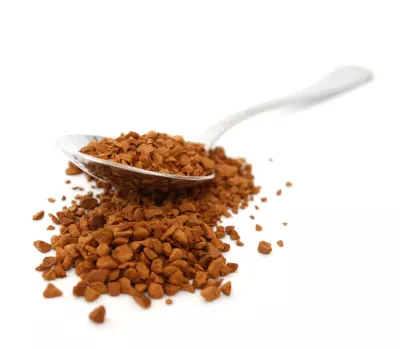
Nutrivore Score for Instant Coffee – 6633
Instant coffee has a Nutrivore Score of 6633, which makes it one of the most nutrient-dense foods (beverages) on the planet! Plus, it is a low-carb and low-calorie-density beverage; the calorie count of brewed coffee is just 2.7 calories per cup!
Per serving, instant coffee is a best source (>50% daily value) of polyphenols.
Ditch Diets. Embrace Nutrients. Start with These 5 Free Guides.
Sign up for the free weekly Nutrivore Newsletter and get 5 high-value downloads—delivered straight to your inbox—that make healthy eating simple and sustainable.
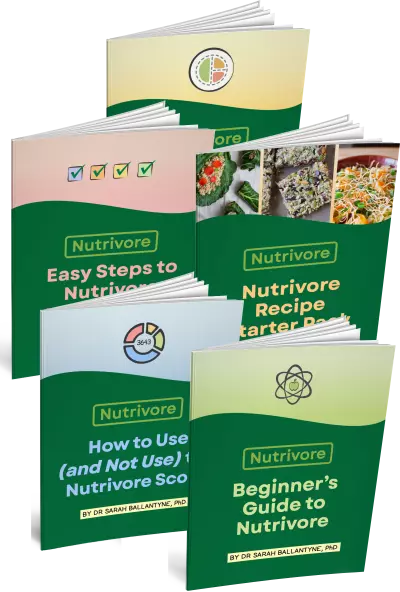
Instant Coffee Nutrition Facts
One serving of instant coffee is standardized to 3/4 cup (6 ounces) of coffee, or approximately 179 grams. For reference, a standard coffee mug typically holds 8 to 10 ounces (240 to 350 mL) of coffee.
Instant Coffee Nutrition Facts Per Serving
| Coffee, instant | Nutrivore Score: 6633 | Nutrient Density: Super! |
|---|---|---|
| Serving Size: 3/4 cup (6 oz) | Protein: 0.2 grams | Net Carbohydrates: 0.6 grams |
| Calories: 4 | Total Fat: 0.0 grams | Dietary Fiber: 0.0 grams |

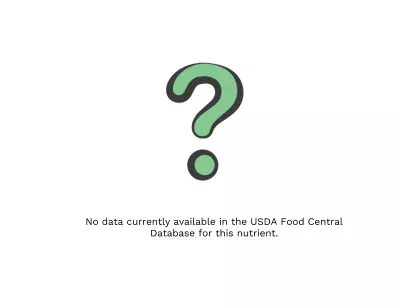

| VITAMINS | ||
|---|---|---|
| Vitamin A | 0.0 μg RAE | 0% DV |
| Vitamin B1 (Thiamin) | 0.0 μg | 0% DV |
| Vitamin B2 (Riboflavin) | 1.8 μg | 0% DV |
| Vitamin B3 (Niacin) | 0.4 mg | 3% DV |
| Vitamin B5 (Pantothenic Acid) | 0.0 mg | 0% DV |
| Vitamin B6 (Pyridoxine) | 0.0 μg | 0% DV |
| Vitamin B7 (Biotin) | 2.8 μg | 9% DV |
| Vitamin B9 (Folate) | 0.0 μg | 0% DV |
| Vitamin B12 (Cobalamin) | 0.0 μg | 0% DV |
| Vitamin C | 0.0 mg | 0% DV |
| Vitamin D (D2 + D3) | 0.0 μg | 0% DV |
| Vitamin E | 0.0 mg | 0% DV |
| Vitamin K | 0.0 μg | 0% DV |
| Choline | 1.0 mg | 0% DV |
| Myo-Inositol | 20.8 mg | ~ |
| CoQ10 | ~ | ~ |
| FUNCTIONAL FATS | ||
|---|---|---|
| MUFA | 0.0 g | 0% DV |
| ALA | 0.0 mg | 0% DV |
| EPA + DHA | 0.0 mg | 0% DV |
| CLA | ~ | ~ |
| Linoleic Acid | 0.0 g | 0% DV |
| MCT’s | 0.0 g | ~ |
| MINERALS | ||
|---|---|---|
| Calcium | 7.2 mg | 1% DV |
| Copper | 19.7 μg | 2% DV |
| Iodine | ~ | ~ |
| Iron | 0.1 mg | 0% DV |
| Magnesium | 7.2 mg | 2% DV |
| Manganese | 26.9 μg | 1% DV |
| Phosphorus | 5.4 mg | 0% DV |
| Potassium | 53.7 mg | 1% DV |
| Selenium | 0.2 μg | 0% DV |
| Sodium | 7.2 mg | 0% DV |
| Zinc | 0.0 mg | 0% DV |
| PHYTONUTRIENTS | ||
|---|---|---|
| Carotenoids | 0.0 μg | ~ |
| Polyphenols | 1720.9 mg | ~ |
| Phytosterols | 0.0 mg | ~ |
| Glucosinolates | ~ | ~ |
| Thiosulfinates | ~ | ~ |
| Betalains | ~ | ~ |
| AMINO ACIDS & PEPTIDES | ||
|---|---|---|
| Taurine | ~ | ~ |
| Ergothioneine | ~ | ~ |
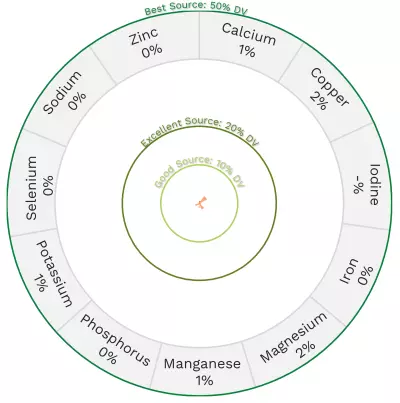
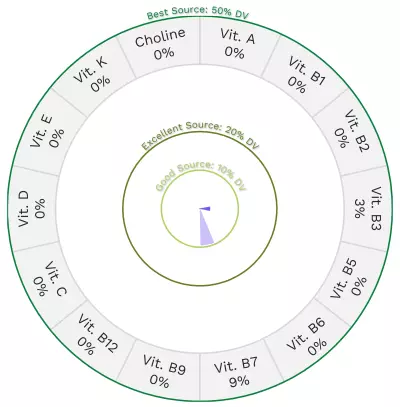

Coffee Nutrition Varies With Processing and Preparation
There are countless ways to enjoy a cup of coffee and each choice impacts the overall nutrition of this popular beverage. The Nutrivore Score of coffee will vary depending on coffee variety, method of preparation and processing. For instance, the most common species of coffee are arabica and robusta, which vary in antioxidant levels; coffee beans also vary between countries and coffee growing regions. In addition, the roasting process (light, medium, or dark) changes the beans physically and chemically, and the method of preparation will also influence the final product – for instance, if the coffee is prepared via French press, percolator, drip, espresso or instant. Lastly, the beverage may be caffeinated or decaffeinated and how it is ultimately enjoyed – with cream, sugar or black, will have a huge impact!
| NUTRIVORE SCORE | |
|---|---|
| Coffee, brewed, espresso, restaurant-prepared | 2304 |
| Coffee, brewed, prepared with tap water | 7036 |
| Coffee, brewed, prepared with tap water, decaffeinated | 1826 |
| Coffee, instant, chicory | 24121 |
| Coffee, instant, decaffeinated, prepared with water | 5523 |
| Coffee, instant, regular, prepared with water | 6633 |
If you loved learning about instant coffee’s nutritional “percs,” maybe your friends will too!
Health Benefits of Instant Coffee Nutrients
Let’s take a closer look at all of the best and excellent source of nutrients found in a 6-ounce serving of instant coffee and see how they benefit our health.
Instant Coffee Provides 1720.9 mg of Polyphenols
Instant coffee is a best source of polyphenols, providing an impressive 1720.9 mg of polyphenols per 6-ounce serving! Most notably coffee is rich in chlorogenic acids, trigonelline, kahweol, and cafestol – with chlorogenic acids being the most potent antioxidants found in coffee .
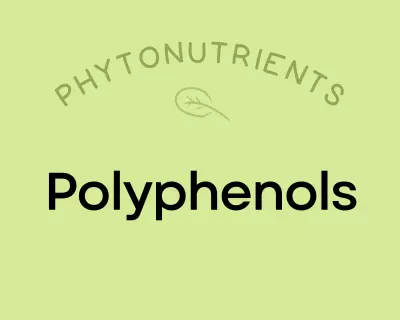
Polyphenols play a huge role in protecting against cancer, heart disease, diabetes, asthma, osteoporosis, neurodegenerative diseases, and other conditions associated with oxidative stress. In fact, a major reason foods like red wine and olive oil (as well as diets rich in both, such as the Mediterranean diet) show up as so beneficial may be due to their high polyphenol content! Along with chronic diseases, supplementing with polyphenols has been shown to protect against infections and reduce the signs of aging. Polyphenols exert their most potent effects by acting as antioxidants—preventing cellular damage by neutralizing hazardous oxygen radicals and improving cellular health as a result (which, in turn, benefits virtually every system in the body). As a result of their antioxidant properties, polyphenols also boost the immune system and protect against both chronic and acute diseases. In addition, polyphenols can help regulate enzyme function, stimulate cell receptors, modulate the functions of inflammatory cells (including T and B lymphocytes, macrophages, platelets, and natural killer cells), alter adhesion molecule expression, affect nerve cells and cardiac muscle cells, and exert antiviral effects. Learn more about polyphenols here.
Learn What Foods Are the Best Sources of Every Nutrient
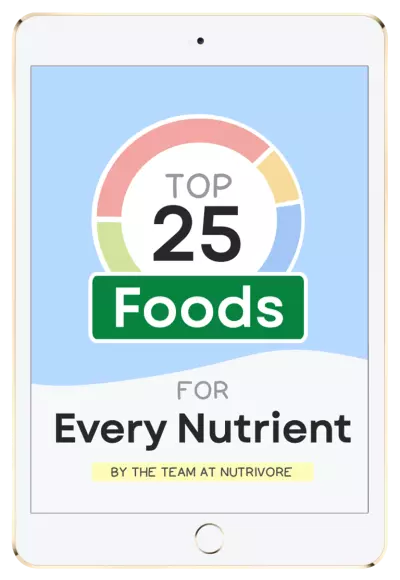
The Top 25 Foods for Every Nutrient
The Top 25 Foods for Every Nutrient e-book is a well-organized, easy-to-use, grocery store-friendly guide to help you choose foods that fit your needs of 43 important nutrients while creating a balanced nutrient-dense diet.
Get two “Top 25” food lists for each nutrient, plus you’ll find RDA charts for everyone, informative visuals, fun facts, serving sizes and the 58 foods that are Nutrient Super Stars!
Buy now for instant digital access.
How Much Coffee Should We Drink Per Day?
Coffee is one of the most commonly-consumed beverages in the world – in fact most of us can’t start our day without our daily fix, but how much is too much?
Coffee contains upwards of 800 different phytonutrients, including being an especially rich source antioxidant polyphenols like chlorogenic acids, plus anti-inflammatory diterpenes like kahweol and cafestol, some cool fiber types that are especially good for the gut microbiome called arabinogalactans and galactomannans, and fiber-like compounds called melanoidins. In addition, caffeine itself is anti-inflammatory. A number of research studies show that drinking coffee in moderation could legitimately provide a range of health benefits, including reducing the risk of certain cancers, stroke, diabetes, Parkinson’s disease, Alzheimer’s disease, cardiovascular disease, gout, gallstones, and depression, along with protecting against antibiotic-resistant bacterial infections and cirrhosis of the liver. It can even reduce muscle soreness after a workout! In fact, a meta-analysis from 2014 found that drinking four cups per day was associated with a 16% reduction in all-cause mortality (as well as a 21% reduction in cardiovascular disease mortality). Unfortunately for coffee lovers, the science on coffee isn’t cut and dried, and there are lots of conflicting studies showing no benefit or even detriment from coffee consumption; in particular, the impact on immune function is complex.

Merch and Household Goods
Check out our collection of practical and nerdtastic T-shirts, totes, and more!
Citations
Expand to see all scientific references for this article.
Clements RS Jr, Darnell B. Myo-inositol content of common foods: development of a high-myo-inositol diet. Am J Clin Nutr. 1980 Sep;33(9):1954-67. doi: 10.1093/ajcn/33.9.1954. PMID: 7416064.
Fineli Finnish Food Composition Database: Coffee, instant, drink
Gorjanović S, Komes D, Laličić-Petronijević J, Pastor FT, Belščak-Cvitanović A, Veljović M, Pezo L, Sužnjević DŽ. Antioxidant efficiency of polyphenols from coffee and coffee substitutes-electrochemical versus spectrophotometric approach. J Food Sci Technol. 2017 Jul;54(8):2324-2331. doi: 10.1007/s13197-017-2672-y. Epub 2017 Jun 19. PMID: 28740289; PMCID: PMC5502025.
USDA Food Central Database: Beverages, coffee, instant, regular, powder
USDA Food Central Database: Beverages, coffee, instant, regular, prepared with water
Watanabe T, Kioka M, Fukushima A, Morimoto M, Sawamura H. Biotin content table of select foods and biotin intake in Japanese. Int J Anal Bio-Sci. 2014. Vol 2(4):109-125.


